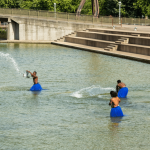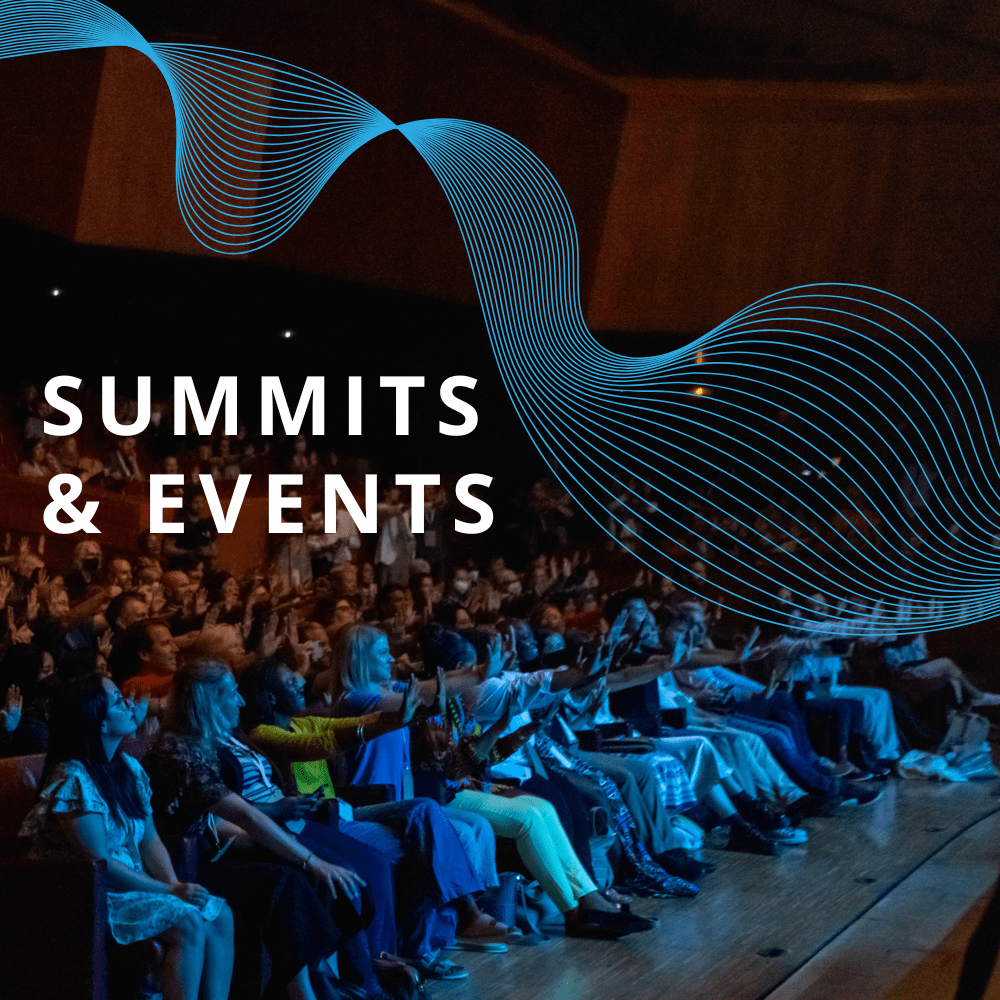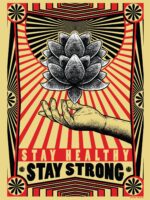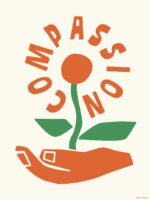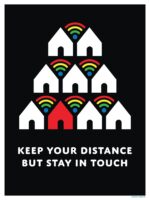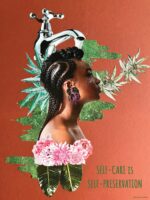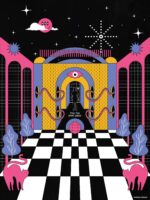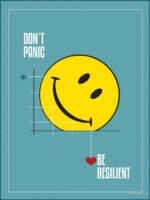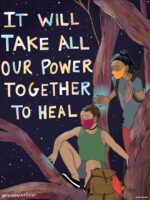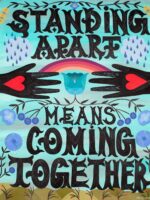
Location: Euskalduna
OPEN TO THE PUBLIC. Visits available upon pre-registration only.
Date: May 31 – June 3
A group of men and women (individually framed by the screens) perform the drumming routine with their cupped hands and fists, which produce different sounds when they strike the surface of the water. These actions, all performed in unison, create a chorus of sounds characterised by the splashing and dripping of water which is reminiscent of the sonic landscape of the ocean and its crushing waves.
The work will also involve a live choreographed dance performance revolving around large galvanised baths filled to the brim with water.
HEALING & THE DRUM
The project explores the correlation between the drum (song, and chant or Ingoma in isiZulu), the ocean, and ancestral memory in the African context. The work conflates the metaphor of drumming as a means of communicating across time, space, and dimensions, with the metaphor of the ocean as a place of prophecy and healing, and a repository of ancestral memory.
As a percussion Instrument, the drum has historically been used in the African context as a means of communication; a type of sonic telegram used to send messages back and for the between far-off neighbouring communities. The drum is also an instrument of ritual practice in the African context. It is played at various cultural and spiritual gatherings often marking moments of divination, mourning, healing, and celebration in a community.
The ocean has been witness to the mass displacement/passage of people moving between continents for many centuries. Some voyages taken for exploration or colonial enterprise, some for escape from persecution, some seeking refuge, and for many others the ocean represents the threshold between home and exile, freedom and bondage.
For the black Atlantic, the ocean simultaneously represents a place of trauma. The Trans-Atlantic slave trade alone is responsible for the mass-displacement of millions of lives which were uprooted and lost in-transit to the new world. For people of African heritage, the ocean also represents a place of ancestral memory and healing. In the African context baptisms, Sangoma initiations, and other cleansings rituals are regularly performed at the ocean where various spirits are thought to reside.
THE WATER DRUMMER conflates the metaphor of drumming as a means to communicate across space and time, and the ocean as the drum or a type of portal into the realm of ancestral memory and spirits as mediated by the sea and its currents.
ESPAÑOL
La obra de Mohau Modisakeng para The Wellbeing Summit for Social Change adopta la forma de una instalación de vídeo multicanal compuesta por pantallas individuales, cada una de las cuales representa una secuencia de tambores de agua ejecutada al unísono por cuerpos medio sumergidos en agua.
Un grupo de hombres y mujeres (enmarcados individualmente por las pantallas) ejecutan la rutina del tambor con sus manos y puños ahuecados, que producen diferentes sonidos al golpear la superficie del agua. Estas acciones, realizadas al unísono, crean un coro de sonidos caracterizado por el chapoteo y el goteo del agua que recuerda el paisaje sonoro del océano y sus olas aplastantes.
La obra también incluirá un espectáculo de danza coreografiada en vivo que girará en torno a grandes bañeras galvanizadas llenas de agua hasta el borde.
SANACIÓN Y EL TAMBOR
El proyecto explora la correlación entre el tambor (canción y canto o Ingoma en isiZulu), el océano y la memoria ancestral en el contexto africano. La obra combina la metáfora del tambor como medio de comunicación a través del tiempo, el espacio y las dimensiones, con la metáfora del océano como lugar de profecía y curación, y depósito de la memoria ancestral.
Como instrumento de percusión, el tambor se ha utilizado históricamente en el contexto africano como medio de comunicación; una especie de telegrama sonoro utilizado para enviar mensajes de ida y vuelta entre comunidades vecinas lejanas. El tambor es también un instrumento de práctica ritual en el contexto africano. Se toca en diversas reuniones culturales y espirituales, a menudo marcando momentos de adivinación, luto, curación y celebración en una comunidad.
El océano ha sido testigo del desplazamiento/pasaje masivo de personas entre continentes durante muchos siglos. En algunos casos, los viajes se han realizado para explorar o realizar empresas coloniales, en otros para escapar de la persecución, en otros para buscar refugio, y para muchos otros el océano representa el umbral entre el hogar y el exilio, la libertad y la esclavitud.
Para los negros del Atlántico, el océano representa simultáneamente un lugar de trauma. Sólo la trata transatlántica de esclavos es responsable del desplazamiento masivo de millones de vidas que se desarraigaron y perdieron en su tránsito hacia el nuevo mundo. Para las personas de herencia africana, el océano también representa un lugar de memoria ancestral y de curación. En el contexto africano, los bautismos, las iniciaciones Sangoma y otros rituales de limpieza se realizan regularmente en el océano, donde se cree que residen diversos espíritus.
THE WATER DRUMMER combina la metáfora del tambor como medio de comunicación a través del espacio y el tiempo, y el océano como tambor o una especie de portal hacia el reino de la memoria ancestral y los espíritus mediados por el mar y sus corrientes.


Yazmany Arboleda - The Hospital for the Soul..
Arts Exhibitions, The Wellbeing Summit for Social Change


Sonja Schenkel - Chrysalis
Arts Exhibitions, The Wellbeing Summit for Social Change
Functional Always active
Preferences
Statistics
Marketing
Nina Millen
KEEP YOUR BODY HEALTHY
In response to COVID-19, The Wellbeing Project, in collaboration with Amplifier Art launched a campaign with top art curators and public-health advisors from around the world, looking for symbols that promote mental health, wellbeing and social change work in this new age.
“I did this as a small reminder to people that it´s necessary to take care of our health when leaving home and having contact with others, giving special importance to hygiene, but in addition we must eat well and keep good habits to strengthen our body, our internal defenses. This is not easy for everyone, many don´t have access to proper food, either for financial reasons or availability, but despite the difficulties we must try our best to take care of ourselves and stay healthy.”
ALESSANDRO VENTRELLA
STAY STRONG
In response to COVID-19, The Wellbeing Project, in collaboration with Amplifier Art launched a campaign with top art curators and public-health advisors from around the world, looking for symbols that promote mental health, wellbeing and social change work in this new age.
TANAYA SHARMA
BE KIND TO YOUR MIND
In response to COVID-19, The Wellbeing Project, in collaboration with Amplifier Art launched a campaign with top art curators and public-health advisors from around the world, looking for symbols that promote mental health, wellbeing and social change work in this new age.
“The artwork aims to portray a positive way to talk about mental health, and how important it is to be kind to yourself. The sprouting leaves and flowers in the brain depict that, the moment you start taking care of yourself, you only bloom and grow. Our mind has infinite capabilities and we need to remember that all thoughts are indeed not true!”
Yohann Yoaz
STAY HOME STAY SAFE
In response to COVID-19, The Wellbeing Project, in collaboration with Amplifier Art launched a campaign with top art curators and public-health advisors from around the world, looking for symbols that promote mental health, wellbeing and social change work in this new age.
“Protect yourself and others.”
Shruti Sinha
NAMA STAY
In response to COVID-19, The Wellbeing Project, in collaboration with Amplifier Art launched a campaign with top art curators and public-health advisors from around the world, looking for symbols that promote mental health, wellbeing and social change work in this new age.
“Introducing Satark Nari, or a cautious woman. She does Namastey instead of shaking hands, wears a mask and maintains social distance. She is breaking the chain. Are you?”
Martyna Smierska
KINDNESS CONTAGION
In response to COVID-19, The Wellbeing Project, in collaboration with Amplifier Art launched a campaign with top art curators and public-health advisors from around the world, looking for symbols that promote mental health, wellbeing and social change work in this new age.
Nana Daye
the care club
In response to COVID-19, The Wellbeing Project, in collaboration with Amplifier Art launched a campaign with top art curators and public-health advisors from around the world, looking for symbols that promote mental health, wellbeing and social change work in this new age.
“A provocation for care in all arenas. Whether it is for ones personal needs, communities or creative visions at large. Care will drive you there and blossom into conscious resolves.”
Sahian Nuez
LIBERA TU MENTE
In response to COVID-19, The Wellbeing Project, in collaboration with Amplifier Art launched a campaign with top art curators and public-health advisors from around the world, looking for symbols that promote mental health, wellbeing and social change work in this new age.
Annie Bekker
SHOW YOURSELF LOVE
In response to COVID-19, The Wellbeing Project, in collaboration with Amplifier Art launched a campaign with top art curators and public-health advisors from around the world, looking for symbols that promote mental health, wellbeing and social change work in this new age.
“I’ve been spending so much time by myself, but not with myself.”
Rahul Sharma
KNOWING
In response to COVID-19, The Wellbeing Project, in collaboration with Amplifier Art launched a campaign with top art curators and public-health advisors from around the world, looking for symbols that promote mental health, wellbeing and social change work in this new age.
“In times like these everyone is vulnerable to mental disorders and a small mishap in our day to day life can trigger a feeling which could make it more difficult for a person to get through this, rather than looking for happiness in the outside world we should try to focus on oneself and look inside by meditation, working out or anything which keeps us active and reduces anxiety. It all starts in your head, knowing yourself is the key for a happier life.”
Karsten Fischer
THE SUN WILL RISE AGAIN
In response to COVID-19, The Wellbeing Project, in collaboration with Amplifier Art launched a campaign with top art curators and public-health advisors from around the world, looking for symbols that promote mental health, wellbeing and social change work in this new age.
“A positive and motivational message symbolizing our resilience and perseverance in these hard times.”
Emma Ismawi
Imagine
In response to COVID-19, The Wellbeing Project, in collaboration with Amplifier Art launched a campaign with top art curators and public-health advisors from around the world, looking for symbols that promote mental health, wellbeing and social change work in this new age.
“What is politically, socially and economically possible has always been about will. When ‘This is all over’ we cannot go back to normal, we the people need to demand and do better. Our collective trauma needs collective healing, out of this darkness we can imagine the revolution.”
JAMIE BENNETT
MENTAL HEALTH
In response to COVID-19, The Wellbeing Project, in collaboration with Amplifier Art launched a campaign with top art curators and public-health advisors from around the world, looking for symbols that promote mental health, wellbeing and social change work in this new age.
FELIPE NOVOA
YOU ARE YOUR HOME – STAY HEALTHY
In response to COVID-19, The Wellbeing Project, in collaboration with Amplifier Art launched a campaign with top art curators and public-health advisors from around the world, looking for symbols that promote mental health, wellbeing and social change work in this new age.
“I want to clarify that not everyone has a house to stay, there are many people in poverty and telling them to stay at home is a contradiction. Through this poster I want to talk about mental health and make a metaphor throughout the home, explaining that it is important to understand ourselves, reflect on our actions and stay calm in our own being in the midst of this difficult situation. Our mind is our own home and we must keep it healthy.”
OSHEEN SIVA
INNER STRENGTH
In response to COVID-19, The Wellbeing Project, in collaboration with Amplifier Art launched a campaign with top art curators and public-health advisors from around the world, looking for symbols that promote mental health, wellbeing and social change work in this new age.
“An homage to inner strength and mental wellness that are paramount to nourish during the current pandemic. Seeking inwards, connecting with loved ones and meditation are couple of ways in which we can tend to our mental well being in these stressful and uncertain times.”
OSHEEN SIVA
WANDER WITHIN
In response to COVID-19, The Wellbeing Project, in collaboration with Amplifier Art launched a campaign with top art curators and public-health advisors from around the world, looking for symbols that promote mental health, wellbeing and social change work in this new age.
“During the current pandemic when the world is restricted to our homes and from travelling outdoors, why not take the opportunity to take a journey within ourselves. Discover new worlds, self reflect, reconnect with oneself all while reducing stress and tending to our mental wellbeing.”
Valerie Gaudreault Guilbert
LETS REACH OUT
In response to COVID-19, The Wellbeing Project, in collaboration with Amplifier Art launched a campaign with top art curators and public-health advisors from around the world, looking for symbols that promote mental health, wellbeing and social change work in this new age.
“During these stressful times, loneliness can be hard for a lot of people and staying home often means feeling isolated. To break this cycle and protect our wellbeing, contacting a family member, a friend or a mental health professional can help us go through this. Let’s reach out.”
SHREE NOOR LAL RAJBHANDA
SELF CARE
In response to COVID-19, The Wellbeing Project, in collaboration with Amplifier Art launched a campaign with top art curators and public-health advisors from around the world, looking for symbols that promote mental health, wellbeing and social change work in this new age.
“Love and peace of mind do protect us. They allow us to overcome the problems that life hands us. They teach us to survive… to live now… to have the courage to confront each day.” —Bernie Siegel
bonnie browN
APART YET CLOSER THAN EVER
In response to COVID-19, The Wellbeing Project, in collaboration with Amplifier Art launched a campaign with top art curators and public-health advisors from around the world, looking for symbols that promote mental health, wellbeing and social change work in this new age.
“Heading into our sixth week of lockdown in New Zealand I’ve been feeling physically distant from those around me, yet closer than ever mentally. From waving to my neighbours from my balcony, to catching up with childhood friends. When we leave lockdown it’ll be with a new sense of community, hope and optimism.”
Bee Harris
FIND YOUR PEACE
In response to COVID-19, The Wellbeing Project, in collaboration with Amplifier Art launched a campaign with top art curators and public-health advisors from around the world, looking for symbols that promote mental health, wellbeing and social change work in this new age.
“This moment in time has heightened the anxieties of many people around the world. Now more than ever, it’s important that we look inward and focus on the things that bring us joy and peace.”
See more from Bee here
Chris Andri Lourens
THINK HAPPY THOUGHTS
In response to COVID-19, The Wellbeing Project, in collaboration with Amplifier Art launched a campaign with top art curators and public-health advisors from around the world, looking for symbols that promote mental health, wellbeing and social change work in this new age.
“This artwork was created as an art piece to remind people to focus on the positive things. It also has a colouring book version which can be downloaded and coloured in for those who need some at-home entertainment.”
See more from Chris-Zandri here
natalia cardona puerta
SUPPORT SYSTEMS GO THE DISTANCE
In response to COVID-19, The Wellbeing Project, in collaboration with Amplifier Art launched a campaign with top art curators and public-health advisors from around the world, looking for symbols that promote mental health, wellbeing and social change work in this new age.
“Even though social distancing has pulled us physically apart, the emotional bonds that we share with our loved ones are still intact and our support system will always be there to help, no matter what. In the meantime, let’s gather in a telepathic embrace, let’s hear our voices over the phone, and let’s read our words of joy & concern through letters. We will hug, and look at each other in the eyes again, and when that day comes, our connection will be stronger than ever.”
See more from Natalia here
Lisa Vollrath
SPREAD COMPASSION
In response to COVID-19, The Wellbeing Project, in collaboration with Amplifier Art launched a campaign with top art curators and public-health advisors from around the world, looking for symbols that promote mental health, wellbeing and social change work in this new age.
“I see nerves getting frayed, from all the staying home, and little inconveniences of our new day to day life. I always try to remember to spread a little laughter when I go out, even if I’m not feeling particularly happy. The world isn’t all about me, and it’s good to have a little compassion for the folks around us right now.”
See more from Lisa here
Danica Ricciardi
TAKE CARE
In response to COVID-19, The Wellbeing Project, in collaboration with Amplifier Art launched a campaign with top art curators and public-health advisors from around the world, looking for symbols that promote mental health, wellbeing and social change work in this new age.
“Protect each other and be kind!”
lindsay-bonavolonta
MENTAL HEALTH
In response to COVID-19, The Wellbeing Project, in collaboration with Amplifier Art launched a campaign with top art curators and public-health advisors from around the world, looking for symbols that promote mental health, wellbeing and social change work in this new age.
“I, like all essential workers, have recently been given an important task; to be the face of resilience during this pandemic. However, while we spend much of our time helping others it can be easy to forget about our own mental health needs as we navigate this new normal.”
See more from Lindsay here
Kahfi Azhary
STAY HEALTHY STAY STRONG
In response to COVID-19, The Wellbeing Project, in collaboration with Amplifier Art launched a campaign with top art curators and public-health advisors from around the world, looking for symbols that promote mental health, wellbeing and social change work in this new age.
This poster has a message for all citizens of the world to remain healthy and strong in the fight against the plague covid19. stay safe, stay home, stay healthy, stay strong.
CAM WATTS
COVID COMPASSION
In response to COVID-19, The Wellbeing Project, in collaboration with Amplifier Art launched a campaign with top art curators and public-health advisors from around the world, looking for symbols that promote mental health, wellbeing and social change work in this new age.
We can’t offer each other our hands, but we can cultivate our compassion garden and be there for each other in other ways during these trialing times. Compassion for the sick, the fearful, the jobless, the old, the young, and the alone. We are all being challenged in different ways right now and compassion for each other is of the utmost importance.
LISA SALDIVAR
KINDNESS NOT CANCELLED
In response to COVID-19, The Wellbeing Project, in collaboration with Amplifier Art launched a campaign with top art curators and public-health advisors from around the world, looking for symbols that promote mental health, wellbeing and social change work in this new age.
A demonstration of kindness from communities around the world shown to inspire a contagion of kindness in these difficult times.
RAUL GUTIERREZ
STAY MINDFUL
In response to COVID-19, The Wellbeing Project, in collaboration with Amplifier Art launched a campaign with top art curators and public-health advisors from around the world, looking for symbols that promote mental health, wellbeing and social change work in this new age.
In the current Covid-19 crisis thinking on the future just makes me experience much anxiety. As I currently see things, there’s no point to think about the future when a storm of uncertainty surrounds us and our lives are on hold. I think it’s time for us to stay mindful, concentrating on the present moment and tackle everyday problems in the calmest way possible. If our mind is overloaded, our capacity response will stay low which won’t allow us to progress. I suggest practicing yoga and meditation as a powerful tool to stay calm and coherent.
ELIZA WOLFSON
STAY IN TOUCH
In response to COVID-19, The Wellbeing Project, in collaboration with Amplifier Art launched a campaign with top art curators and public-health advisors from around the world, looking for symbols that promote mental health, wellbeing and social change work in this new age.
In the current Covid-19 crisis thinking on the future just makes me experience much anxiety. As I currently see things, there’s no point to think about the future when a storm of uncertainty surrounds us and our lives are on hold. I think it’s time for us to stay mindful, concentrating on the present moment and tackle everyday problems in the calmest way possible. If our mind is overloaded, our capacity response will stay low which won’t allow us to progress. I suggest practicing yoga and meditation as a powerful tool to stay calm and coherent.
See more from Raul here
GIANCARLO MANCUSO
HOPE
In response to COVID-19, The Wellbeing Project, in collaboration with Amplifier Art launched a campaign with top art curators and public-health advisors from around the world, looking for symbols that promote mental health, wellbeing and social change work in this new age.
This poster is a symbolic expression of Hope. The color yellow is known to be the colour of hope, and happiness. All the images illustrated are used to express hope, peace, love, and the fight against COVID-19. See more from Giancarlo here
KIMBERLY ASHBY
SELF CARE
In response to COVID-19, The Wellbeing Project, in collaboration with Amplifier Art launched a campaign with top art curators and public-health advisors from around the world, looking for symbols that promote mental health, wellbeing and social change work in this new age.
Kimberly Marie Ashby is a Black and Native American, queer, woman artist, activist, and doctoral candidate in counseling psychology. Kimberly creates hand-cut collages through an Afrofuturist lens, using found materials to reflect marginalized people’s ability to make marvels out of the scraps they are given. Kimberly created this hand-cut collage To express the importance of self-care, particularly for Black and Brown people in the US who are being disproportionately impacted by COVID-19.
SHIRIEN DAMRA
LET YOURSELF REST
In response to COVID-19, The Wellbeing Project, in collaboration with Amplifier Art launched a campaign with top art curators and public-health advisors from around the world, looking for symbols that promote mental health, wellbeing and social change work in this new age.
Capitalism tries to push the idea that we need to be productive. A lot of us feel like we need to constantly hustle and be on the grind to achieve our dreams. But giving yourself time to rest and take care of yourself is a gift that can empower you. It sounds counter-intuitive, but rest ultimately allows you to be in a stronger place to tackle whatever comes your way. But we are in a global pandemic right now. It’s necessary to rest and breathe and check in with yourself!
See more from Shirien here
YASH PRADHAN
THIS TOO SHALL PASS
In response to COVID-19, The Wellbeing Project, in collaboration with Amplifier Art launched a campaign with top art curators and public-health advisors from around the world, looking for symbols that promote mental health, wellbeing and social change work in this new age.
“Even if you’re isolated, you’ve to remind yourself you’re not alone in this. Staying home can be uninspiring, times passes slower but remember this too shall pass.”
See more from Yash here
DAMIEN CIFELLI
JUST REMEMBER TO BREATHE
In response to COVID-19, The Wellbeing Project, in collaboration with Amplifier Art launched a campaign with top art curators and public-health advisors from around the world, looking for symbols that promote mental health, wellbeing and social change work in this new age.
“My poster is one of a series of three original oil paintings. I used oil due to its association with portraits of important historical figures, adding gravity to the message in the poster. The idea is to insert the mask into attractive and aspirational images, representing the idea of wearing a mask as a positive thing. Each poster is based around the word breathe. Firstly – around the literal idea of being able to breathe freely by wearing a mask, secondly – allowing the planet the space to breathe by doing your part and thirdly – addressing the anxiety that comes with the unknown elements of the crisis.”
DAMIEN CIFELLI
LET THE PLANET BREATHE
In response to COVID-19, The Wellbeing Project, in collaboration with Amplifier Art launched a campaign with top art curators and public-health advisors from around the world, looking for symbols that promote mental health, wellbeing and social change work in this new age.
“My poster is one of a series of three original oil paintings. I used oil due to its association with portraits of important historical figures, adding gravity to the message in the poster. The idea is to insert the mask into attractive and aspirational images, representing the idea of wearing a mask as a positive thing. Each poster is based around the word breathe. Firstly – around the literal idea of being able to breathe freely by wearing a mask, secondly – allowing the planet the space to breathe by doing your part and thirdly – addressing the anxiety that comes with the unknown elements of the crisis.”
damien cifelli
BREATHE
In response to COVID-19, The Wellbeing Project, in collaboration with Amplifier Art launched a campaign with top art curators and public-health advisors from around the world, looking for symbols that promote mental health, wellbeing and social change work in this new age.
“My poster is one of a series of three original oil paintings. I used oil due to its association with portraits of important historical figures, adding gravity to the message in the poster. The idea is to insert the mask into attractive and aspirational images, representing the idea of wearing a mask as a positive thing. Each poster is based around the word breathe. Firstly – around the literal idea of being able to breathe freely by wearing a mask, secondly – allowing the planet the space to breathe by doing your part and thirdly – addressing the anxiety that comes with the unknown elements of the crisis.”
Skye Sturm
SPREAD LOVE
In response to COVID-19, The Wellbeing Project, in collaboration with Amplifier Art launched a campaign with top art curators and public-health advisors from around the world, looking for symbols that promote mental health, wellbeing and social change work in this new age.
“I created this artwork because I wanted to celebrate all of the acts of selflessness and kindness, both big and small, that we have seen during the pandemic. But I was also seeing so much hatred and blame. I wanted to remind people to withhold judgement, to remember that we are all in this together and that a little kindness goes a long way. Even wearing a mask and maintaining distance is an act of kindness and respect to those around us. I chose the rainbow and sunshine as a bright and positive backdrop to the message – the symbol of hope, of rays of sunlight which shine through in a dark storm. I hope this message can help people to stay positive, and that it encourages everyone to spread a little love in these difficult times.”
Varshini Ramakrishnan
GOOD DAYS NOT FAR AWAY
In response to COVID-19, The Wellbeing Project, in collaboration with Amplifier Art launched a campaign with top art curators and public-health advisors from around the world, looking for symbols that promote mental health, wellbeing and social change work in this new age.
“It’s time to manage the voice of the Media and take control of the voices inside our heads. The media content we’ve been consuming since Covid-19 has taken a toll on our thoughts and emotions. We feel the urge to stay up to date on the current happenings and tend to incline towards negativity. This artwork is inspired by vintage advertisements, portraying the importance of a mental cleanse. Visual media like advertisements, cinema etc, have always been part of our mental growth. I visualise the voice of media to be more positive and break stereotypes around mental illness.”
María toro
mind-aware world-awake
In response to COVID-19, The Wellbeing Project, in collaboration with Amplifier Art launched a campaign with top art curators and public-health advisors from around the world, looking for symbols that promote mental health, wellbeing and social change work in this new age.
“If we all connect our minds and stay aware, the world will wake up. MIND AWARE- WORLD AWAKE!”
VARSHINI RAMAKRISHNAN
MIND MEDIA POSITIVITY
In response to COVID-19, The Wellbeing Project, in collaboration with Amplifier Art launched a campaign with top art curators and public-health advisors from around the world, looking for symbols that promote mental health, wellbeing and social change work in this new age.
“It’s time to manage the voice of the Media and take control of the voices inside our heads. The media content we’ve been consuming since Covid-19 has taken a toll on our thoughts and emotions. We feel the urge to stay up to date on the current happenings and tend to incline towards negativity. This artwork is inspired by vintage advertisements, portraying the importance of a mental cleanse. Visual media like advertisements, cinema etc, have always been part of our mental growth. I visualise the voice of media to be more positive and break stereotypes around mental illness.”
ALEJANDRO VARELA
DON’T PANIC, BE RESILIENT
In response to COVID-19, The Wellbeing Project, in collaboration with Amplifier Art launched a campaign with top art curators and public-health advisors from around the world, looking for symbols that promote mental health, wellbeing and social change work in this new age.
“This work riffs off the famous phrase of the Indian spiritual master Meher Baba, “Don’t worry; Be happy,” later converted into song by Bobby McFerrin in 1988. Its concise message of positivity has at times been misunderstood as careless or passive, but simplicity is powerful and mantras like these continue to be used because they encourage us during challenging times. While its difficult to be happy in the face of this crisis and the uncertainty it brings, together we can withstand the curve, flatten it, and recover- not through worry or panic, but through collaboration as a world community. With this work, I want to express a simple message for all of us: to resist fear-mongering messages and to focus on our innate human resilience.”
PACO ESPINAR
HOPE HOME
In response to COVID-19, The Wellbeing Project, in collaboration with Amplifier Art launched a campaign with top art curators and public-health advisors from around the world, looking for symbols that promote mental health, wellbeing and social change work in this new age.
ANIRUDH KADAV
BREATHE
In response to COVID-19, The Wellbeing Project, in collaboration with Amplifier Art launched a campaign with top art curators and public-health advisors from around the world, looking for symbols that promote mental health, wellbeing and social change work in this new age.
“The nearer a man comes to a calm mind, the closer he is to strength’ In my opinion, mental health is the most overlooked aspect of human nature. Seldom we give it the attention it deserves. No amount of wealth guarantees ones well being and current global scenario is a reflection of the same. At the moment, when the world is facing a, what seems to be an immortal, enemy, no amount of wealth or militia is enough to fight it. In these times, when people are forced to be at home, take a step back and reflect. As much effort is being put in maintaining and enhancing physical strength, try and focus on your inner peace as well. What makes you happy? A question, to which most of us have an answer to, but rarely do we act on it. We have always been too pre occupied with things and troubles, which now do not seem to matter as much. So let’s take a deep breathe, and focus on what is more important – YOU. Be the change you wish to see in the world. World peace, begins at Inner peace. Stay Positive. Stay Home. Stay Safe”
RUCHITA ASHOK
PRAY FOR THE WORLD
In response to COVID-19, The Wellbeing Project, in collaboration with Amplifier Art launched a campaign with top art curators and public-health advisors from around the world, looking for symbols that promote mental health, wellbeing and social change work in this new age.
“The modern pandemic COVID-19 will define this era absolutely. No one who lives through will forget the pain that people are feeling now and will continue to feel for years to come. Meanwhile on the other hand this will define brotherhood, humanity, faith, strength, courage and kindness.There is always a light at the end of tunnel but while going through that darkness nobody knows if there is any, but it is the faith and hope and willpower that keeps us driving through hardships to reach the brighter side. Pray for our world, pray for all!”
RUE OLIVER
GATHER OUR POWERS
In response to COVID-19, The Wellbeing Project, in collaboration with Amplifier Art launched a campaign with top art curators and public-health advisors from around the world, looking for symbols that promote mental health, wellbeing and social change work in this new age.
RAHUL JAIGADKAR
GYAN MUDRA
In response to COVID-19, The Wellbeing Project, in collaboration with Amplifier Art launched a campaign with top art curators and public-health advisors from around the world, looking for symbols that promote mental health, wellbeing and social change work in this new age
“Coping with the pandemic is getting harder and harder with each passing day. With so much of information freely available to read, our mind is filled with numerous thoughts such as the lotus surrounded by dirtiest water. As the lotus produces the most beautiful lotus flower from this dirty water, Gyan Mudra helps us to purify our thoughts.”
VINITHA BASKARAN
HOPE AND LOVE
In response to COVID-19, The Wellbeing Project, in collaboration with Amplifier Art launched a campaign with top art curators and public-health advisors from around the world, looking for symbols that promote mental health, wellbeing and social change work in this new age
“The world will be a better place with an abundance of Hope and Love. In this difficult time of year, Let us all hope that this too shall pass and spread as much as love as possible to one another.”
TROY CHAFIN
NATURE HEALS
In response to COVID-19, The Wellbeing Project, in collaboration with Amplifier Art launched a campaign with top art curators and public-health advisors from around the world, looking for symbols that promote mental health, wellbeing and social change work in this new age
“Nature (the sun, trees, plants, animals, and so on) is the greatest source of therapy for humans that has ever existed. Everything in nature is meant to heal us. In this age of isolation, yes, the world needs messages of action, staying in separation from each other, and helping one another. But in addition to this, we all also need messages of calming hope. That everything will be ok. Get some sunshine on your face, and connect with your plants and pets inside your home. Nature will heal us.”
Ruchita Ashok
HOPE
In response to COVID-19, The Wellbeing Project, in collaboration with Amplifier Art launched a campaign with top art curators and public-health advisors from around the world, looking for symbols that promote mental health, wellbeing and social change work in this new age
“Hope can be a powerful force, especially in difficult times. Today, the world is facing the coronavirus crisis, a pandemic that has changed lives for millions of people, so Let’s stand strong behind every fighter and to donate non-profits organizations providing relief during Covid-19 and taking all precautionary measures. Stay safe at home. And most importantly, remember prevention is better than cure.🌼”
Ruchita Ashok
BELIEVES
In response to COVID-19, The Wellbeing Project, in collaboration with Amplifier Art launched a campaign with top art curators and public-health advisors from around the world, looking for symbols that promote mental health, wellbeing and social change work in this new age
“Every little donation will help in making sure that somebody doesn’t sleep hungry.”
BUNNIE REISS
HOPE
In response to COVID-19, The Wellbeing Project, in collaboration with Amplifier Art launched a campaign with top art curators and public-health advisors from around the world, looking for symbols that promote mental health, wellbeing and social change work in this new age
“I created these posters as a way to connect with the world during a time of such complete isolation. My hope is that they help others to see the light at the end of the tunnel. The only real way for us to get through this is together.
BUNNIE REISS
STANDING APART
In response to COVID-19, The Wellbeing Project, in collaboration with Amplifier Art launched a campaign with top art curators and public-health advisors from around the world, looking for symbols that promote mental health, wellbeing and social change work in this new age
“I created these posters as a way to connect with the world during a time of such complete isolation. My hope is that they help others to see the light at the end of the tunnel. The only real way for us to get through this is together.”
EMILY PERELMAN
SUPPORT EACH OTHER
In response to COVID-19, The Wellbeing Project, in collaboration with Amplifier Art launched a campaign with top art curators and public-health advisors from around the world, looking for symbols that promote mental health, wellbeing and social change work in this new age.
Digital illustration representing themes of support, coming together, and shining a light in a time of darkness, by Emily Lynn Perelman.
See more from Emily here
EMILY PERELMAN
SUPPORT EACH OTHER
In response to COVID-19, The Wellbeing Project, in collaboration with Amplifier Art launched a campaign with top art curators and public-health advisors from around the world, looking for symbols that promote mental health, wellbeing and social change work in this new age.
Digital illustration representing themes of support, coming together, and shining a light in a time of darkness, by Emily Lynn Perelman.
See more from Emily here
LENDL ROMERO
SACRIFICES
In response to COVID-19, The Wellbeing Project, in collaboration with Amplifier Art launched a campaign with top art curators and public-health advisors from around the world, looking for symbols that promote mental health, wellbeing and social change work in this new age.
A Greater risk of everything in life is what our Medical People are willing to sacrifice fighting this life threatening pandemic. Most countries are not prepared and it comes with a prize . My art speaks everything lacking on our Health Care System . We may get through this soon but we need to provide them the liberty and support they need . To our Front liners we salute and pray for the strength you put into despite the lack of measures of our Government. (Ray thorns & Sun represents the hero / liberty image)
KIMBERLY ASHBY
SELF CARE
In response to COVID-19, The Wellbeing Project, in collaboration with Amplifier Art launched a campaign with top art curators and public-health advisors from around the world, looking for symbols that promote mental health, wellbeing and social change work in this new age.
Kimberly Marie Ashby is a Black and Native American, queer, woman artist, activist, and doctoral candidate in counseling psychology. Kimberly creates hand-cut collages through an Afrofuturist lens, using found materials to reflect marginalized people’s ability to make marvels out of the scraps they are given. Kimberly created this hand-cut collage To express the importance of self-care, particularly for Black and Brown people in the US who are being disproportionately impacted by COVID-19.
Thank you to all organizations and partners who are part of this network
AFRICAN LEADERSHIP UNIVERSITY
INDIAN SCHOOL OF DEVELOPMENT MANAGEMENT
KOÇ UNIVERSITY
MONDRAGON UNIVERSITY
STANFORD UNIVERSITY
TECNOLOGICO DE MONTERREY (MONTERREY INSTITUTE OF TECHNOLOGY AND HIGHER EDUCATION)
THE UNITED NATIONS INSTITUTE FOR TRAINING AND RESEARCH (UNITAR)
UNIVERSITY OF CAPE TOWN (UCT)
UNIVERSITY OF NORTH TEXAS AT DALLAS
UNIVERSITY OF VIRGINIA
YUKON UNIVERSITY CANADA
Thank you to all organizations and partners who are part of this group
Thank you to all organizations and partners who are part of this network
4DLAB
ACCELERATE2030 & IMPACT HUB GENEVA
ACIC-CACI
ACCESS NOW
AGORA PARTNERSHIPS
ARGIDUS
AMANI INSTITUTE
ANDE
ASHOKA EUROPE FELLOWSHIP
ASHOKA UK
ASPEN INSTITUTE
BETTERPLACE
BIZKAIA TALENT
BMW FOUNDATION HERBERT QUANDT
CIRCULAR ECONOMY
COMMUTINY – THE YOUTH COLLECTIVE
COMMUNITAS AMERICA
CONVENERS.ORG
CHANEL FONDATION
DASRA
DREAM IN TUNISIA
ECHOING GREEN
EKSKÄRET FOUNDATION
EUFORIA
ELDERS COUNCIL
FURTHER
GIZ
GLOBEMED
GOODLAB
GUERILLA FOUNDATION
GLOBAL SHAPERS MENTAL HEALTH INITIATIVE
GLOBAL FUND FOR CHILDREN
GLOBAL GRASSROOTS
HIL FOUNDATION
HISPANICS IN PHILANTHROPY
IDEX GLOBAL
IMPACT HUB GLOBAL
IMPACT HUB STOCKHOLM
IMPACT HUB ODESSA
IMPACT HUB ZAGREB
IMPACT HUB DRESDEN
IMPAQTO
LEARNING FOR WELLBEING FOUNDATION
LUMINATE
MELTON FOUNDATION
MOBDIUN
NAMASTE FOUNDATION
NEXUS
PHINEO
PIONEERS OF CHANGE
PLAYVERTO
RECIPES FOR WELLBEING
REOS PARTNERS
ROHINI NILEKANI PHILANTHROPIES
ROOT IMPACT
SISTEMA B
SKOLL FOUNDATION
STEELCASE
SOCIAL ENTERPRISE ALLIANCE (SEA)
SOCIAL IMPACT AWARD
TEACH FOR ALL
TENDREL
THE HOLDING CO.
THE PHILANTHROPY WORKSHOP
THE SAVILLE FOUNDATION
THE YOUNG GLOBAL LEADERS COMMUNITY OF THE WEF
UNIDOS EN RED
URGENT ACTION FUND
UNFINISHED
WE LOVE READING (WLR)
WOMEN’S ALLIANCE FOR SECURITY LEADERSHIP (WASL)
WORLD INNOVATION SUMMIT FOR EDUCATION (WISE)
how would you like to contribute?
NOTABLE RESEARCH FINDINGS
Only 2 studies out of 102 studies on teacher wellbeing conducted in the last 5 years were in low-income countries; this report offers findings from 2 additional low-income countries. People who study teacher wellbeing recommend improvements to the school atmosphere, but no studies of school-level or policy interventions were found.
Engagement:
When on the cusp of burnout, some teachers said that getting more deeply engaged in their work, for example by leading the school-wide IT team or serving on a district-wide committee, prevented burnout.
Successful students:
Teachers experienced wellbeing when they saw their students win awards or achieve their goals, and liked this as much or more than receiving awards themselves.
Relationships affect each other:
Teachers, principals, students, parents, and policymakers’ behaviors and attitudes intertwine. Improving one may help them all. Teacher wellbeing across these actors was related to respect, praise, motivation, and hard work.
BEALIGHT FOUNDATION
CARRERESI FOUNDATION
CHOU FAMILY
GRIGGS FAMILY FOUNDATION
NORTHPINE FOUNDATION
JAVIER ENTRECANALES & FAMILY
JESSE ESTRIN
JESSE & JULIE RASCH FOUNDATION
LARRY LUNT
MARIE CLAIRE DE BAUW
MAITE ARANGO
NOMMONTU FOUNDATION
RICHARD VENN
ROHIT AND SONAL CHOPRA
ROHINI NILEKANI PHILANTHROPIES
RALPH TAYLOR
SAMIRA RAUTER
TONY & FLAVIA PEREIRA
WATSON FAMILY FOUNDATION
YANN BORGSTEDT



